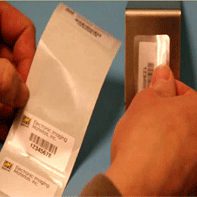
Benjamin: Yes, sir.
Mr. McGuire: Are you listening?
Benjamin: Yes, I am.
Mr. McGuire: Plastics.
Benjamin: Just how do you mean that, sir?
You may think that you want a paper label, but—then again—you may need something a bit more durable and tear-resistant. Plastics! Just how do we mean that, eh?
Plastic is the general common term for a wide range of synthetic or semi-synthetic organic amorphous solid materials suitable for the manufacture of industrial products― including labels. Plastics are typically polymers of high molecular weight, and may contain other substances to improve performance and/or reduce costs.
Plastics are classified by their chemical structure, namely the molecular units that make up the polymer’s backbone and side chains. Some familiar classifications include acrylics, polyester, silicones, polystyrene, polyethylene, polypropylene, polycarbonate, acetate, poly-vinyl chloride (aka PVC or vinyl), and other specialty polymers. In the label business we tend to call our plastic labels “films” since they are thinner variations of solid blocks of plastic.
Paper labels are great for some applications—like retail products or paperwork—that involve handling a job for either a short period of time (short “shelf life”) or without much stress. [That’s a job we all want!!] Yet what if there are stressors on the labels? These stressors include exposure to high heat, nasty chemicals, freezing temperatures, dousing in water or high-traffic abrasion. Paper simply won’t do the job here.
Plastic labels have substantial advantages over paper:
- First of all, plastic labels are much more conformable than paper. The “memory” or tendency to lay flat that paper exhibits can cause a paper label to fail if the surface is curved, irregular or highly textured. Some films stretch (polypropylene) while others are deliberately thin and brittle to be used for tamper-evidence (acrylic or polyethylene) so that you have to chip at them like peeling paint to get them off your item.
- The adhesive on plastic labels will last longer and perform better. Adhesives used on paper labels tend to migrate into the paper and over time, will discolor the material and lose their strength. You also find a much wider choice of adhesives for plastic labels to meet very specific surface conditions.
- Plastics tend to have high-tensile strength and excellent dimensional stability that makes certain films extremely tear-resistant (polyester and polycarbonate).
- Plastics generally have some form of environmental resistance (ultraviolet/UV light, heat, cold, humidity) and many are popular for outdoor usage. They offer excellent service temperature ranges, good moisture barriers, and weatherability (polyester, polyimide and vinyl, to name a few).
- Plastic labels can also be cleaner, solvent, stain and chemical resistant. A common list of serious substances that challenge labeling may include detergents, oils and alcohol and lead to some really noxious elements like gasoline, anti-freeze and grease. And yet there really ARE plastic labels to fit the bill; it just depends on how they are pretreated and printed.
- Plastic labels have certain aesthetic advantages as well. For instance, if you want your label to look like a metal tag, a paper label simply won’t work even though there are some paper foil products that are shiny and “look pretty”. And what if you want a CLEAR label for a no-label look―plastic is the answer―not a wannabe frosty paper.

One area that confuses a lot of people is the term “synthetic paper.” This is a relatively new way to describe materials that look and feel like paper. They are apt to cost less than plastic, can be water-resistant―even chemical resistant―and environmentally-friendly, but they still contain a certain amount of plastic. It’s interesting that sometimes you can find the same product described in one place as a “synthetic paper” and in another, as a “plastic” with a fancy trade name. No wonder we get confused! As popularity for this form of material grows, it’s important not to set expectations too high and to remember what sort of print quality and dimensional stability you really need.
Need a label that can survive a deep freeze? Have you ever tried applying a label to an oily machine part? How about a label to withstand printed circuit board manufacture at 600°F? Can a paper label do that? Un-uh. No way. Tilt. Game over.




